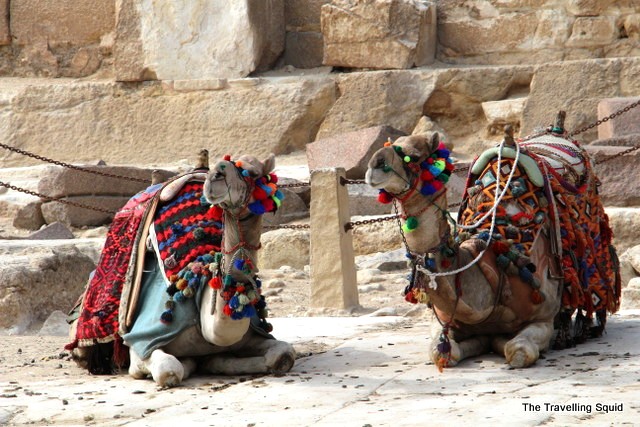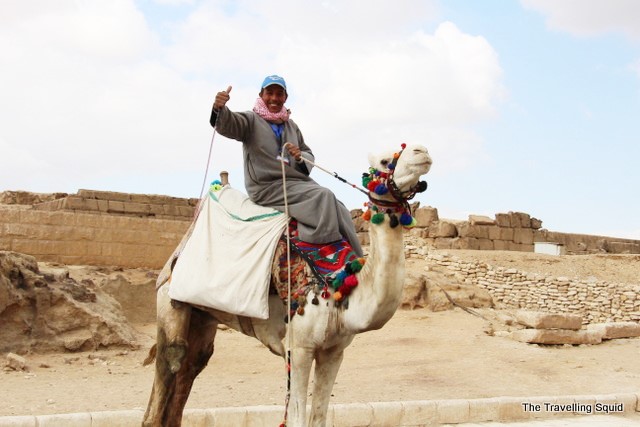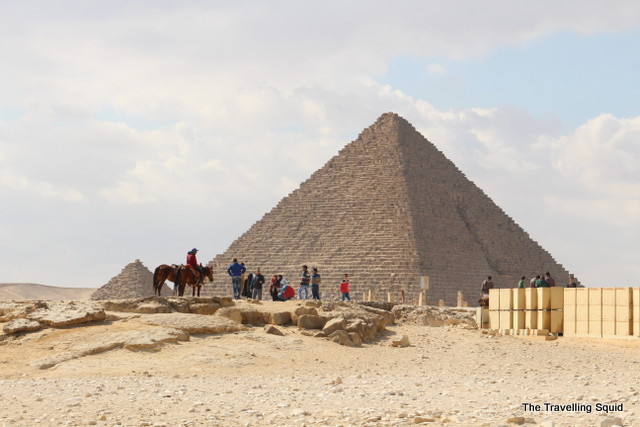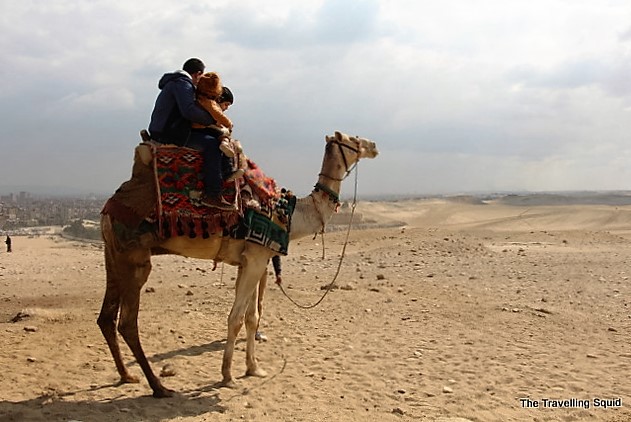Beware of camel scams at the Pyramids of Giza! (Part 1)

Over the years, I would like to think that my style of writing has mellowed. I strive to be balanced and present my readers with the pros and cons. But this is an exception. I would urge you readers to never, ever ride a camel when you visit the Pyramids of Giza. I’m not simply asking readers to beware of camel scams at the Pyramids of Giza, but to think of the camel’s welfare. I’m not discounting the fact that legit operators do exist, but the probability of meeting one is low.
* * *
When I heard that there were camel rides available at the Pyramid complex in Giza, I thought that it was a happy convenience. I admit that while camel riding was super touristy, (and The Travelling Squid usually tries to avoid such activities), this was something I could not do without. I could not leave the Middle East without riding a camel.
To me, it was the highlight of the trip. For some reason, I was just fascinated by the humps of the camel’s back, its long lashes and soulful eyes. At the Pyramids, I envisioned seeing groups of healthy and smiling camels. Friend S and I were not prepared to face a multitude of adversity that faced us, just to ride a camel.
It is a sad occurrence in Egypt, that our experience with seemingly friendly and helpful locals usually end up with them trying to scam us in one way or another. A case in point is the camel driver at the Pyramids of Giza.
* * *
We arrived at the Pyramids, only to learn that the stream of tourists to the Pyramids had dried up, leaving the mules and camels free from the weight of affluent, plump tourists. Despite having less loads to carry, many of them of them looked thin, and weary. They definitely did not appear fresh and happy, like the horses I had seen in an Australian farm many years ago.
But the camels caught my eye. Unlike the strong sturdy camels you would see in documentaries, these camels were white, less furry, were smaller in size and had smaller humps.

As we moved on from the Pyramid of Khufu to the Pyramid of Khafre, a camel trotted past us. I took the opportunity to whip out my DSLR, against my instinct that the camel driver would ask for a tip for taking photos. But he didn’t and instead showered us with a wide grin and posed with the camel. Later on while looking through the photos, I realised he had propped the camel’s neck with a rope. :/

He then proceeded to ask if we would fancy a camel ride and we said No. We wanted to explore the Pyramid complex on foot. But he was persistent. €200 (Egyptian pounds) (USD23, SGD40), he said, for a ride for two, which will take us to a point in the desert, where the three pyramids would be in view, and then over to the Sphinx, which was about a kilometre away.

Sunlight was streaming through the clouds that Egyptian spring, and we started perspiring through our sweaters. The push and pull factors combined, we acceded to his persistence and two of us got on the camel. I found the price of SGD40 reasonable, only that there was a nagging feeling in me that there was something amiss.
Misrepresentation of the pricing
Now a camel ride is not as stable as the nomads would have portrayed it to be. For us, it was wobbly, and I was extremely fearful that I was about to fall from this poor, frail animal, two metres in height. Now that we were finally on the camel, the rider asked us to pay up, and he introduced a new condition. The price was now €200 for each of us. Essentially, SGD40 per person, bringing the total to SGD80.
We were very angry. Friend S had heard him mention that the price was €200 for the two of us. It’s not that we could not afford that SGD80. It was just in bad faith that he was asking money from us when we were in a rather compromising position – on the camel. A shouting match ensued. ‘You’re lying to us!’ ‘I said before, it’s €200 for ONE person’, was the reply, with him emphasizing the word, one.

Now as the shouting continued, I started to feel rather dizzy (like I might fall off anytime). Out of exasperation, I fished out an extra €200 from the pocket of my jeans and handed it to him. (On hindsight, we should have demanded to get down from the camel, given the despicable tactics he had employed.)
The thing is, we were fine with paying SGD80 for a 30 minute camel ride, for two people. It was expensive, but given that it was the Pyramids, it seemed that the experience would have been worth it. What we could not tolerate was the despicable way this transaction was conducted. Put us on a camel, make us feel unsafe, and try to extort as much money as he could from us. That’s terrible.
And that was not the end.
After the €200 had changed hands, a larger camel had parked right next to Friend S. It’s body was literally right at his leg. “One person, one camel,” said the camel driver. “Two people, too heavy for one camel. No additional fee.”
He was pushing his luck. We were really pissed off. I started shouting too, “That’s not what you said when we got on! You a******! What do you take us for? Do you think we will still trust you again. You’re a LIAR!” It was my turn to start gesturing. Just then, a plump Egyptian man and two kids on a camel came to view. “Look there! SEE! There are three people on the camel!”

And that to prove that we are dead serious, Friend S used his leg to push the other camel away.
Now I was rather conscious of our weight on the camel. (It was a rather slim one and I felt really bad about it.) But given the situation, it was not wise for Friend S and I to be separated. Goodness where these Scammers would have brought us to and attempt to extort more money from us. We tried to comfort ourselves thinking that our combined weight could be that of a really heavy person.
(I was pretty guilt-stricken about this. As research for this article, I did a Google search and found that camels can take about 200 pounds (90kg) for distances in heat. According to Livescience.com, some can carry up to 500 pounds (200kg) on its back. It does make me feel slightly better, given that our combined weight of 110kg was manageable after all.
And so, this is how the camel ride started. The manipulative camel driver tried to make peace with us by asking us our names, and where we are from.

But if you thought this ride couldn’t get any worst, it did. Until today, it still pricks my conscience. Stay tuned for Ill treatment of camels at the Pyramids (Part 2) next week.

Leave a Reply